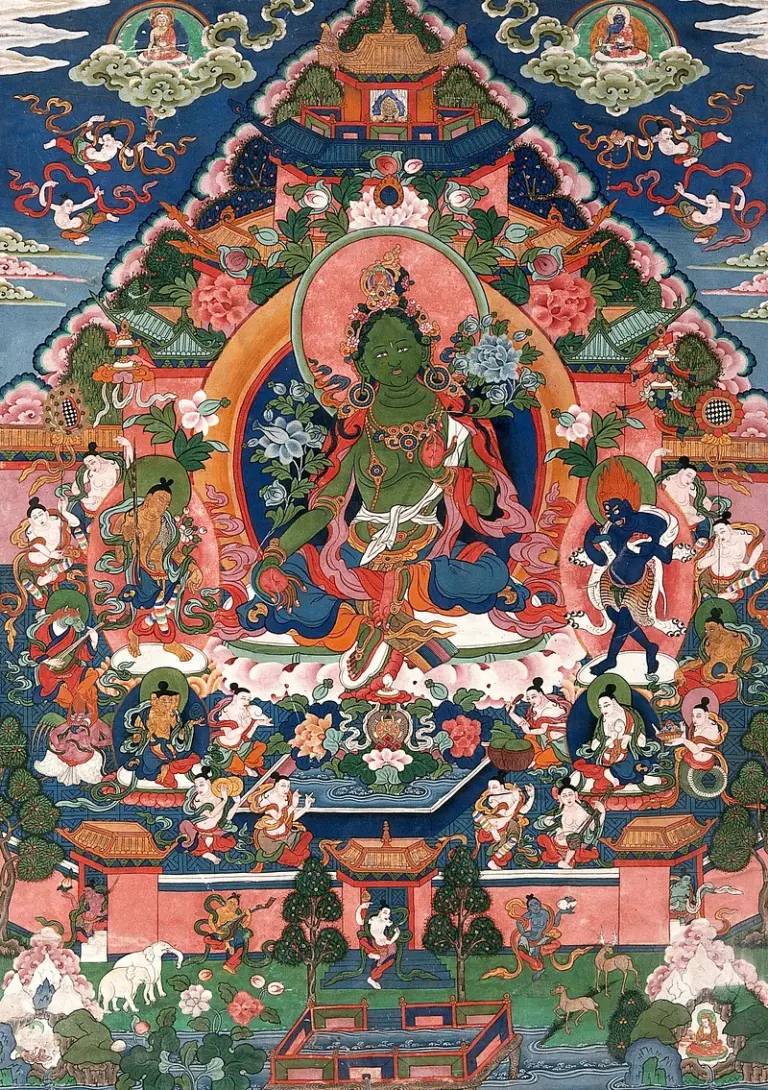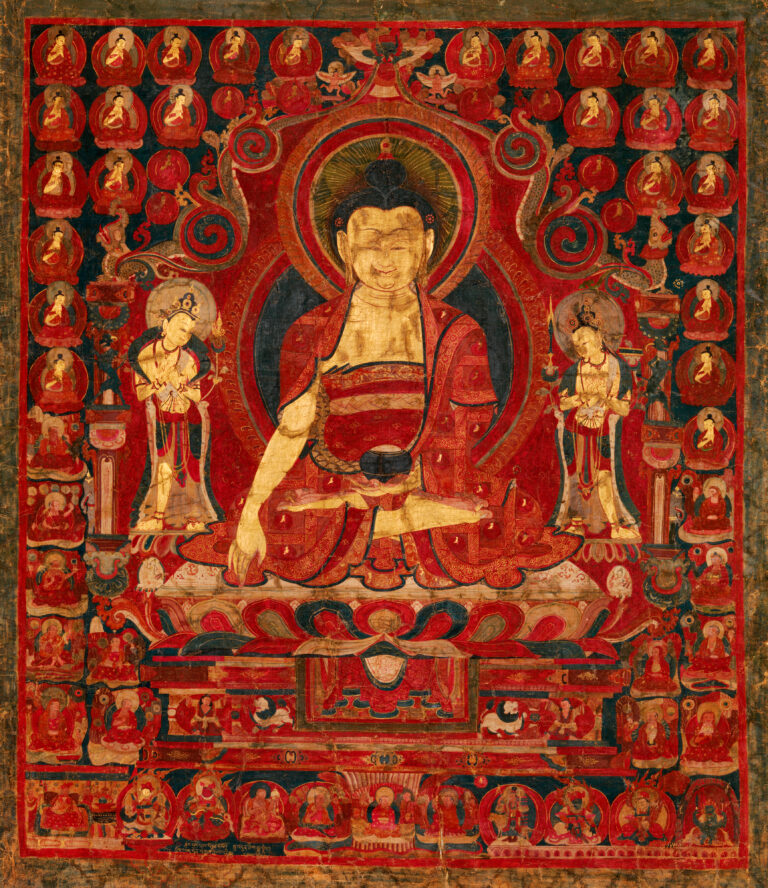Tara is revered as the chief Holy Mother of Himalayan Buddhism, a divine embodiment of compassion in action. Tara was the first tantric goddess I met, the first practice I ever engaged with. Since then, the goddess has been a constant companion, both in my spiritual practice and my general life. The practice of Tara is often recommended to beginners in tantric buddhism, yet it is also a practice that has taken many to full enlightenment.
According to her origin story, she arose from the tears of Avalokiteshvara, the Buddha of Compassion. Overwhelmed by the suffering of beings trapped in pain, anger, loneliness, and fear, Avalokiteshvara shed tears of boundless compassion. From those tears, Tara emerged—not only as a goddess but as the living answer to his despair. Where he felt powerless, she arose as active compassion: love in motion. In a sacred vow, Tara pledged to take rebirth in female form for as long as sentient beings remained trapped in cyclic existence, appearing in whatever form they needed to awaken.
Yet Tara is far more than a spiritual figure. She is an energy, a principle woven into the very fabric of reality itself. The world is often frightening—rife with war, hunger, disease, and isolation—but it is also a place of kindness, warmth, and unexpected grace. Tara is that grace. She is the spiritual presence that fills the void created by fear and helplessness. Whenever someone cries out for help, it is Tara who answers. She is the subtle force that moves through the world in gestures of care and courage, an embodiment of love that is responsive, intimate, and ever-present.
The name “Tara” has layered meanings that reveal her essence. One interpretation is “She Who Overcomes,” or “Saviouress,” pointing to her role in helping beings transcend suffering. The name derives from the Sanskrit root tar, which is also found in the word “nectar”—the divine elixir that bestows immortality in Greek myth. In this sense, Tara is the force that carries us across the turbulent ocean of suffering toward liberation. Another interpretation links her name to “star,” as tara also means “star” in Sanskrit. As such, Tara is the light that shines when all others are dimmed, gilding the night sky. Stars are lights in the darkness and points of orientation. In this light, Tara becomes a cosmic guide—the constant, radiant beacon by which we navigate life’s uncertainties. The opportunity to always choose love. Above all, Tara is known as the Mother of all Buddhas, for it is love—the courageous impulse to serve others, even in the face of despair—that gives birth to awakening. Tara, the embodiment of love, is both what gestates awakening, what nourishes it, and what expresses it in the world.
In traditional thangka paintings, most Buddhas are depicted in seated, meditative postures, resting in awakening. They are unmovable. Tara, however, is unique. While her left leg is folded in the classic pose of meditation, her right leg extends outward, symbolizing her willingness to step into the world. She unites serene awareness with compassionate action. Her posture is a teaching: it is not enough to cultivate love inwardly—we must live it outwardly. Many of us are afraid to act from the heart. We worry our kindness will be taken for granted, our generosity exploited, or our vulnerability seen as weakness. These fears are not unfounded and often confirmed by the world. That is why choosing love requires immense courage. True courage arises not in the absence of fear, but in its company, in the resolve to act despite it. Tara sees our hesitation and meets it with the gesture of fearlessness. Her right hand is raised in the abhaya mudra, the mudra of fearlessness—a promise that the power of open-heartedness ultimately triumphs over fear.
Tara is not just a goddess, but a presence that moves through the world. She acts on both the spiritual and physical planes. Sometimes, she takes form through other people: the friend who lifts your spirits, the stranger who offers unexpected help. She manifests whenever you choose patience over anger, or when you find the strength to ask for help and are met with care. In those moments, you are encountering Tara—or even embodying her yourself. We can thus train ourselves to meet and worship the goddess not only in the temples and during pujas, but every time we step out into the world. She is there, if we acquaint ourselves with seeing her.
We live in a time that glorifies self-sufficiency and individualism. We are taught to value independence, to avoid needing others. But this illusion isolates us. Human beings are biologically wired for connection; we cannot thrive—sometimes not even survive—without love. Babies deprived of affection die. Adults deprived of connection suffer, dying prematurely and in silence. We are not isolated individuals, but an interconnected whole. We must both be Tara, and receive Tara: be courageous enough to ask for the descent of grace, and be ready to give it when called for. Tara is the force that responds when our defenses crack and we cry out for help. Many spiritual masters describe moments of utter crisis—times of complete despair and darkness—as the gateways to awakening. In those moments, stripped of control and certainty, we become open and receptive. The beauty of marriage and friendship is precisely in the risk it entails. When we give our hearts to someone, we do it with the knowledge that they might destroy it, and herein lies the beauty of that gift, the courage of the action. It is when we step out of predictability and into unchartered territory, both spiritually and in daily life – that grace finally has the room to enter us.True transformation begins when we step beyond the familiar, without guarantees. Like love, which always carries risk, the spiritual path demands that we make ourselves vulnerable. Tara’s extended foot stepping from her lotus throne is that very act: a bold, loving gesture into the unknown.
As stated earlier, Tara has many forms. Traditionally, there are 21 different emanations of Tara, the Green Tara – or Swift Heroine – beings the most popular one. These different emanations represent different expressions of the great mother, both as a spiritual force and as an energy moving through the world. Tara meets us where we are – in the form that we need her to take, in the same way that we should strive for skill and elegance in our service to each other. When facing suffering, we should never judge, but rather inquire as to how we might be of service, and in what way that goal might be attained. Some forms of Tara are fierce, with weapons in her hands and sharp fangs, representing the ability to bring protection to the weak, and break through obstacles. Some forms are erotic, symbolizing magnetism and sensuality – that which attracts our attention and draws us towards something. All forms of Tara, however, are simply instruments of love, skillful precision in service to compassion. The different forms of Tara, from blue-coloured, wrathful Ekajati to radiantly white, motherly Chenma, are all expressions of the open space of love. They teach us that compassion is not always gentle and passive. Sometimes, compassion is almost violent in its fierceness, as manifested in the great humanitarian revolutions in the world. If we remain passive witness to someone’s destruction, refraining from action in order to avoid conflict, we’re cowardly and cowardice is the direct opposite of love. When compassion needs to break through old, ingrained and heavy structures, it must express itself in an explosive form. It must raise its voice and demand attention. Other times, compassion might be seductive. We might need to draw someone out of their suffering using bait. We might need to change our appearance and demeanor in order to please someone in order to, rather than break through their defenses as Blue Tara, sneak past them, and sow the seeds of awakening in their minds. All the forms of the Mother of the Buddhas represent different skillful methods, upaya in Sanskrit, employed in the service of wisdom.
As a personal anecdote, I always change the way I teach – even the way I speak, depending on the circumstances. I even dress differently, and use different segways to get to the same point, depending on who I am teaching to. Sometimes, I am soft-spoken and gentle. Often, I use raunchy humour and frivolity and sometimes, although rarely, I express myself fiercely and abruptly. These are calculated actions, based on how I think I might get past the defenses of the students most effectively. If I am teaching a businessman and show up for the class in harem-pants and with a crystal on my head, he will immediately write me off, label me and be defensive to whatever I am saying. If I, on the other hand, dress smartly and use a certain set of words that does not conflict with, but rather harmonize, with his existing world-view, the effect of my words will be much stronger, and sink much deeper. As spiritual practitioners, we should follow the example of the Goddess Tara, and be adaptable and versatile in our service to the world. We should never be constrained by identity or community, but rather be fluid in our movements and strive for a spacious sense of self, so that we effortlessly can be embodiments of the Goddess in the way people need, whether that be in the form of a soldier, a secret agent, or a selfless friend. This is the essence of Tara – the teaching of her 21 manifestations – her boundless expressions: love adapts. It is not confined to identity or dogma, or to one expression, but flows freely, always seeking the most skilful way to serve – the path of least resistance.
May I become at all times, both now and forever
A protector of those without protection
A guide for those who have lost their way
A ship for those with oceans to crossA bridge for those with rivers to cross
A sanctuary for those in danger
A lamp for those without light
A place of refuge for those who lack shelter And a servant to all in needFor as long as space endures,
And for as long as living beings remain, Until then may I, too, abide
To dispel the misery of the world.






